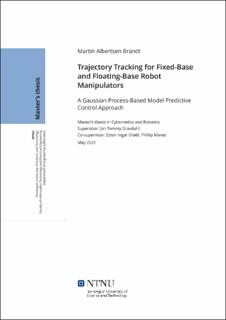| dc.description.abstract | Modellprediktiv regulering (MPC) er et nyttig rammeverk for banefølging med robotmanipulatorer. Ytelsen er derimot avhengig av en nøyaktig model av dynamikken til systemet, som spesielt for robotmanipulatorer med flytende base ikke nødvendigvis er lett tilgjengelig. I dette arbeidet håndteres usikkerheten i den dynamiske modellen ved å kombinere en Gaussisk prosess (GP) med en tilbakekoblingslinearisert model av dynamikken. Denne modellen anvendes i en stokastisk MPC regulator, hvor kostnadsfunksjoner i både leddrommet og oppgaverommet blir tatt i betraktning. Sparsomme GP metoder blir anvendt, i tillegg til en sekvensiell kvadratisk programmering (SQP) sanntidsiterasjon (RTI) løser, for å oppnå sanntid beregningstid for systemer med både statisk og bevegelig base.
Resultater fra simuleringer og labeksperimenter for en robotmanipulator med statisk base og 6 frihetsgrader blir presentert. Videre blir resultater fra simuleringer av en frittflytende robotmanipulator i verdensrommet også presentert. MPC regulatoren med GP-dynamikk ble sammenlignet med en ulineær MPC basert på den opprinnelige modellen og en tilbakekoblingslinearisert MPC uten GP-dynamikken. Det ble funnet at forbedringer i prediksjonsnøyaktighet og banefølgingsfeil kunne bli oppnådd med metoden med GP-modellen. Prediksjonsnøyaktigheten var derimot bare lokal til banen som ble brukt for å trene GPen. Resultatene viste allikevel at GP-basert MPC, og generelt metoder basert på ulineær MPC, kan følge kompliserte baner for leddvinkler eller posisjon og orientering med høy nøyaktighet i sanntid, for både robotmanipulatorer med statisk base og bevegelig base. | |
| dc.description.abstract | Model Predictive Control (MPC) provides a useful framework for trajectory tracking for robot manipulator arms. However, the performance is highly dependent on an accurate model of the system dynamics, which, especially for floating-base robot manipulators, are not necessarily easy to obtain. In this work, uncertainty in the dynamical model is handled by adding a learned Gaussian process (GP) model to a feedback linearization-based prior dynamics model, which aims to model the error between the prior and true dynamics. This augmented model is added in a stochastic MPC formulation, where both joint space and task space trajectory tracking costs are considered. Furthermore, sparse GP methods, primarily the Sparse Variational Gaussian Process (SVGP) method, are applied. This is used in conjunction with a sequential quadratic programming (SQP) real-time iteration (RTI) solver to achieve real-time feasible computation time for both fixed-base and floating-base manipulators systems.
Specifically, results from simulations and lab tests for a 6 degrees of freedom (DOF) fixed-base robot manipulator are presented, as well as simulation results for a free-floating space manipulator system. The GP-based MPC was compared to a Nonlinear Model Predictive Control (NMPC) approach using only the prior dynamics, as well as the feedback linearization-based approach without the added GP disturbance model. It was found that significant improvements in prediction and trajectory tracking accuracy could be achieved with the GP-based MPC approach. However, the high prediction accuracy of the GP was only local around the training trajectory. Yet the results showed that GP-based MPC, and more generally NMPC approaches, can follow challenging joint and pose trajectories with low tracking error and real-time feasible computation time, for both fixed-base and floating-base robot manipulator systems. | |
